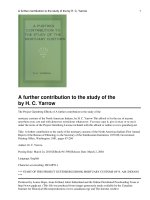A grand old village of the north
Bạn đang xem bản rút gọn của tài liệu. Xem và tải ngay bản đầy đủ của tài liệu tại đây (40.35 KB, 5 trang )
A Grand Old Village Of The North
The village of Duong Lam, Ha Tay province, 40 kilometers west of Ha Noi, has a history of
over 3,000 year. With the population of 8,000, its residents live in houses make of
laterite bricks, stone based posts, a wooden windows. Up to now, the village still retains
its ancient features such as banyan trees, old wells, village gate.
The village has long been famous for such beautiful architecture relics as the village gate,
communal houses, pagodes, temples. The most significant are Ngo Quyen Mausoleum
and Phung Hung shrine. Despite the tribulations of history, the village has kept its
ancient relics and special architectural works undamaged.
Arriving in Duong Lam village, tourists are attracted not only by the architectural relics
but also by the beauty of dark red of the laterite brick in the village gate’s porch and
walls. The ancient feature are clearly noticed or seen from the gate of pagodas,
communal houses, especially from the village’s gate, which is under a big banyan tree
and beside a river in a scene specific to the north.
Duong Lam village also surprises many tourists with hundereds of house of over 600
year old, with fishbone alleys( a main road and many other small road linked to it) which
allow people to get back home regardless of the way they take.Thus, Duong Lam is
valued by local and international researcher as a unique relics of traditional heritage.
This old village expresses a great cultural asset that rarely exists elsewhere.
CUSTOMS OF VIETNAM
Vietnamese people generally shake hands when greeting and parting. They can use both
hand to show respect. Younger people must also bow slightly to elderly people. Women
needn’t shake hands with others. They are more likely to bow the head slightly than
shake hands.
The Vietnamese have a strong sense of hospitality and feel ambarrassed if they cannot
show their guests full respect by preparing for their arrival. Therefore, you shouldn’t visit
a home without having been invited. You needn’t always bring gifts but flowers, fruit, or
tea are appreciated. Hosts also appreciate small gifts for their children or elderly
parents.
Rice is the staple (main) food of Vietnam. Fermented fish sauce called nuoc mam is the
main seasoning used to flavor dishes; special foods are also dipped in it. Vietnamese
people use spoons for soup, and chopsticks for other dishes. At the table, you can serve
food to other people if you want. However, it is usual for people to help themselves from
dishes in the center of the table and place the food in their rice bowl; they always hold
their rice bowl in their hand while eating from it.
Traditionally, marriages were arranged by parent, but now people choose their own
partner. On average, men can marry at age 25 and women around age 23. Family
member maintain strong ties and provide one another with assistance and support as
need. In rural areas it is normal for the extended family (grandparents, aunts, uncles,
mother, father, children) to share the same home, while in urban areas it has become
more common for only the nuclear family (mother, father, children) to live together.
Celebrating the deeds of kings
The day to commemorate the ancient Hung kings is the 10th of lunar March every year.
Since 2007, this memorial day has become a national holiday, and it has been given
more prominence throughout Vietnam.
On this day, many activities such as offering flowers and joss-sticks and praying are
conducted to commemorate Hung kings who founded the nation. These activities are
followed by orther activities to honor the exclusive features of Vietnamese culture.
Cultural activities include displaying calligraphy (the art of beautiful hand-writing),
writing parallel sentences and performing a tea ceremony.
In Phu Tho province, the stronghold of Vietnam in ancient times, at the Hung kings’
Temple,a pair of giant glutinous rice cakes (one round, one quare) is offered to the kings.
Some artistic performances with the participation of hundreds of actor, actresses and
representatives of 54 ethnic group are also held at the festival.
Vietnamese people believe that the holiday in an opportunity to arouse national pride,
recognize the traditional cultural values of the Vietnamese, and remind all citizens of the
glorious history of the nation. It is a chance for Vietnamese people to remember their
origin and advance into the future confidently.
(Adapted from Saigon Time, May 5, 2007 by Thanh Tung)
City life
City life in Vietnam very busy with million of people that rush around on their bicycles,
and motor bikes. There are plenty of shops as well as hotels and restaurants.
In Ho Chi Minh city, the biggest city in Vietnam, there are many beautiful building that
were built by French. People also see large hotels as well as supermarkets and
restaurants. When the festival of Tet arrives, parts of the city are full of beautiful flowers
for sale.
The main forms of transport are bicycles and motor bikes. Tourists and locals often use
threewheeled bicycles called cyclos. From time to time, some cars, taxis and motor bikes
sound their horns to get the bicycles and pedestrians out of the way; therefore the cities
are busy and noisy.
When walking on the treets, you can smell the strong scents of food which is being
cooked at the street stalls. Bread rolls, fruit, noodles, bottled water and cigarettes are
also for sale. Along the street of the cities, a pump and a bowl of water is bicycle repair
shop, a mirror and a chair is a barber shop, and a chair and a box is a choe shine. The
streets of the cities are busy with people that are on their way to work in shops, offices
and factories.
In the cities some houses are made out of brick and have tiled roofs. The older houses
are in poor condition and often have no water or electricity. Some new houses are three
storeys high and others are brightly painted. Many Vietnamese live in high apartment
building where 3 generation can live in one apartment.
Adapted from City life By Melanie and Angela
( />
Why I live in the city
Many people who are living the city claim that city life is bad. However, I believe that city
life brings us many benefits which village people can hardly have. First , there are many
coffee shops, food stalls, restaurants which open early in the morning and late at night.
Therefore, I can eat out whenever I want. Second, people in the city can access good
healthcare services which are still rare in the countryside. There are many hospitals
which are both public and private ones with lots of good doctors who have good
experience and expertise. Last but not least, city people have many ways to relax such as
watching good programs from cable TV, swimming in a water part or going dancing in
discotheques which become rather popular in big cities.
Workers in need of housing
Millions of workers from rural areas have migrated to Ha Noi and Ho Chi Minh City to
work in economic zones around these to big citiesof Vietnam. Many of them are in
urgent need of housing. The Viet Nam Confederation of Labour (VCL) reports that over
one million workers are employed at 154 industrial parks (IPs) and export processing
zones (EPZs) around the country. More than 70 per cent of the workers are migrants.
They have had_to rent dormitories in slums near their factories. Workers spend between
60,000VND and 150,000VND from their average salaries of 800,000-900,000 VND a
month for house rent.
House buil by State and businesses have only provided with accommodation for seven to
ten per cent of the country’s IP and EPZ workers. Although some construction companies
have built several apartment building in recent year, the rent are still very high. This has
forced workers to seek cheap room for rent. According to authorities in Ha Noi and Ho
Chi Minh City, the construction of low-cost accommodation for workers became an
urgent task for both cities.
Last year, Ha Noi businesses invested in dormitories for workers of Bac Thang Long’s IPs
but they can house only 9,000 workers out of 66,000 migrant workers. HCM City-based
Truong Thinh Construction Company is building a low-cost dormitory to provide
accommodaton for 800 workers.
In order to solve the problem of housing, the State should offer incentives to attract
vestors to build low-cost dormitories for workers. These incentives would include credit
loan at low interest rate, between six and eight per cent a year. Investors can rent public
land at low cost for housing project for at least 20 year, and the State will take back the
land in cases of bankruptcy of businesses.
Crimes in Vietnam and tips to protect oneself
Although mót travelers in Vietnam feel relatively safe, pick-poketing and petty crimes
sometimes occur. Violent crimes such as armed against westerners or tourists remain
rare. Drug use, which contributes significantly to crime, is an increasing problem in
Vietnam.
Petty theft,purse snatching, and pick pocketing are most common in the areas
frequented by foreigners such as major hotels, tourist site, and public parks. One
common method of purse snatching used thoughout Vietnam employs two people on a
motorcycle with the passenger snatching the victim’s bag, camera, cell phone, etc. –
often while traveling at the same speed or faster than street traffic. This method can be
especially dangerous to victims if the straps of the bag are over the shoulder or around
the neck, as the victim can be pulled down or dragged by the strap until it breaks.
To protect themselves, visitors/residents should never leave possessions unattended,
particularly in public areas such as airports, parks, restaurants, hotel lobbies, etc. theft of
briefcases, luggage, laptops, and other items can occur when the owner’s attention is
momentarily lost. Visitor should also make use of the safety and security of guest room
in quality hotels. Valuables and important documents (i.e. passports) should be kept
inside a safe in the room or in a safety deposit box at the front desk. If they are on
guided tour, they will have to secure their personal bags and, if possible, do not leave
them on the tour bus/boat. If they have to leave the bag, they may need to remove any
valuables.
Those who plan to reside in Ho Chi Minh City for an extended period of time should seek
to lease or rent homes and apartments that are properly equipped with crime
prevention devices, especially against home break-ins.
In highly populated Vietnam, whose small landmass of 330,000 square kilometers holds
80 million people, a major concern has always been transportation. Efficient and
inexpensive scooters and motorbikes have become the most popular way of movement
of many inhabitants of the large metropolitan centers. The downside of this trend is the
environmental effects of pollution generated primarily from two-stroke engines that can
emit as much as or even more exhaust than large semi trucks.
Two-stroke engine powered vehicles burn an oil-gasoline mixture, emitting more smoke,
carbon monoxide, hydrocarbons, and particulate matter than their four-stroke cousins.
Unfortunately these engines are cheaper to buy and easier to maintain. In Ho Chi Minh
City, many city dwellers have set up their own independent “baby taxis” by simply
adding carts to their small motorbike and scooters. This makes the dirty two stroke
engines work even harder because of their insufficient power to carry 2 or more
passengers, so releasing even more exhaust than ever.
According to The World Health Organization, it is essential that these highly populated
cities monitor and regulate these environmentally harmful vehicles because as air
pollution grows worse and worse, increasing numbers of the inhabitants are infected
with respiratory illness. This results in overloading hospitals, and increasing the mortality
rate. New research has recently shown that Liquefied Petroleum Gas (LPG) helps
motorbikes and scooters run on a cleaner burning fuel.
LPG is a mixture of propane and butane; the simple makeup of these two gases fuse
beautifully into one of the cleanest burning fuel alternatives available today. LPG
powered engines or hybrid LPG and gasoline-powered engines are cleaner burning not
only for the environment but within the engines as well. Engine durability and longevity
is increased because LPG does not create the particulate or soot created in two-stroke
gasoline engines. This new invention can ensure a safer environment today and in the
future.









